2001 AUDI A4 relay
[x] Cancel search: relayPage 45 of 88
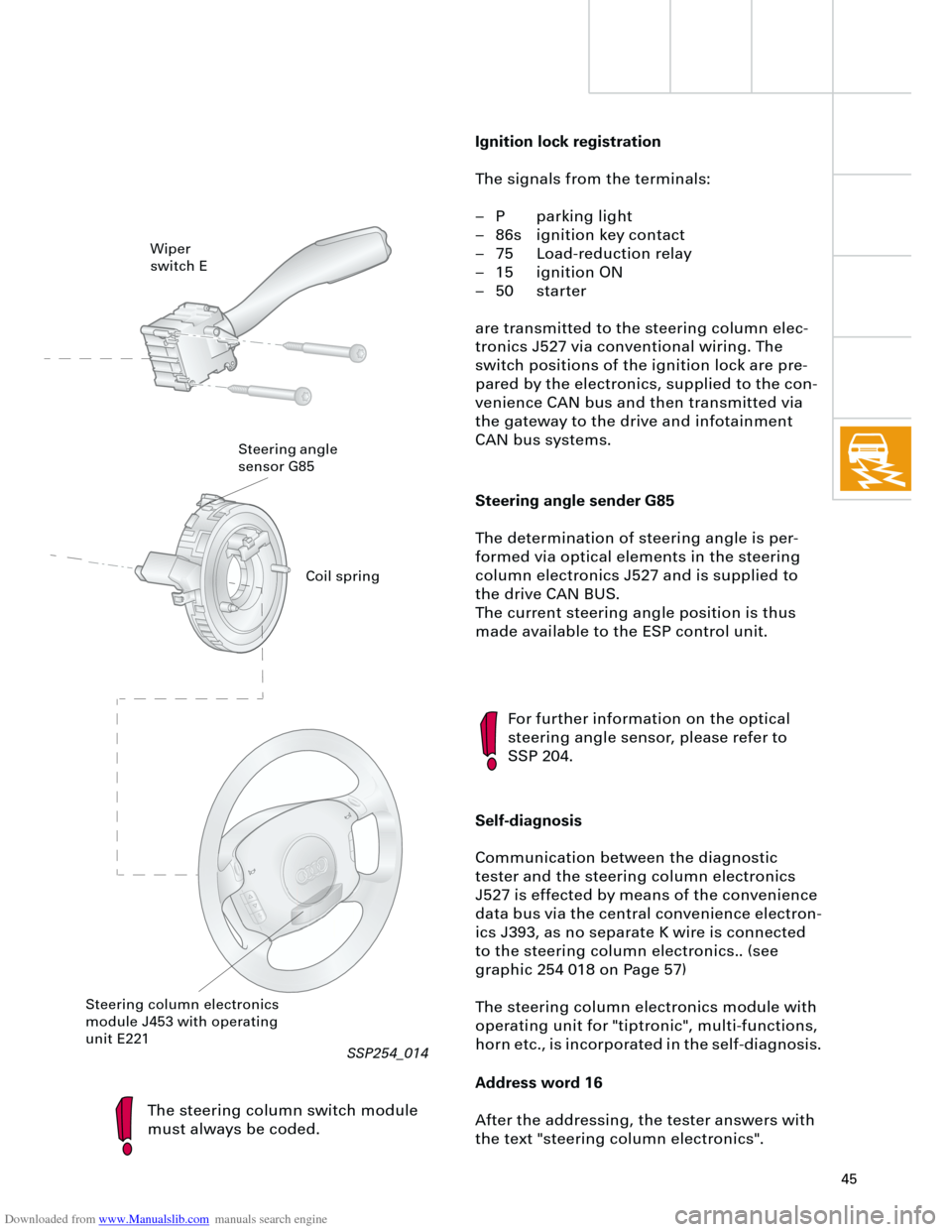
Downloaded from www.Manualslib.com manuals search engine
45
Steering angle sender G85
The determination of steering angle is per-
formed via optical elements in the steering
column electronics J527 and is supplied to
the drive CAN BUS.
The current steering angle position is thus
made available to the ESP control unit.
The steering column switch module
must always be coded.
For further information on the optical
steering angle sensor, please refer to
SSP 204.
Self-diagnosis
Communication between the diagnostic
tester and the steering column electronics
J527 is effected by means of the convenience
data bus via the central convenience electron-
ics J393, as no separate K wire is connected
to the steering column electronics.. (see
graphic 254 018 on Page 57)
The steering column electronics module with
operating unit for "tiptronic", multi-functions,
horn etc., is incorporated in the self-diagnosis.
Address word 16
After the addressing, the tester answers with
the text "steering column electronics".
Wiper
switch E
Steering angle
sensor G85
Steering column electronics
module J453 with operating
unit E221
Ignition lock registration
The signals from the terminals:
– P parking light
– 86s ignition key contact
– 75 Load-reduction relay
– 15 ignition ON
– 50 starter
are transmitted to the steering column elec-
tronics J527 via conventional wiring. The
switch positions of the ignition lock are pre-
pared by the electronics, supplied to the con-
venience CAN bus and then transmitted via
the gateway to the drive and infotainment
CAN bus systems.
Coil spring
RT
SSP254_014
Page 48 of 88
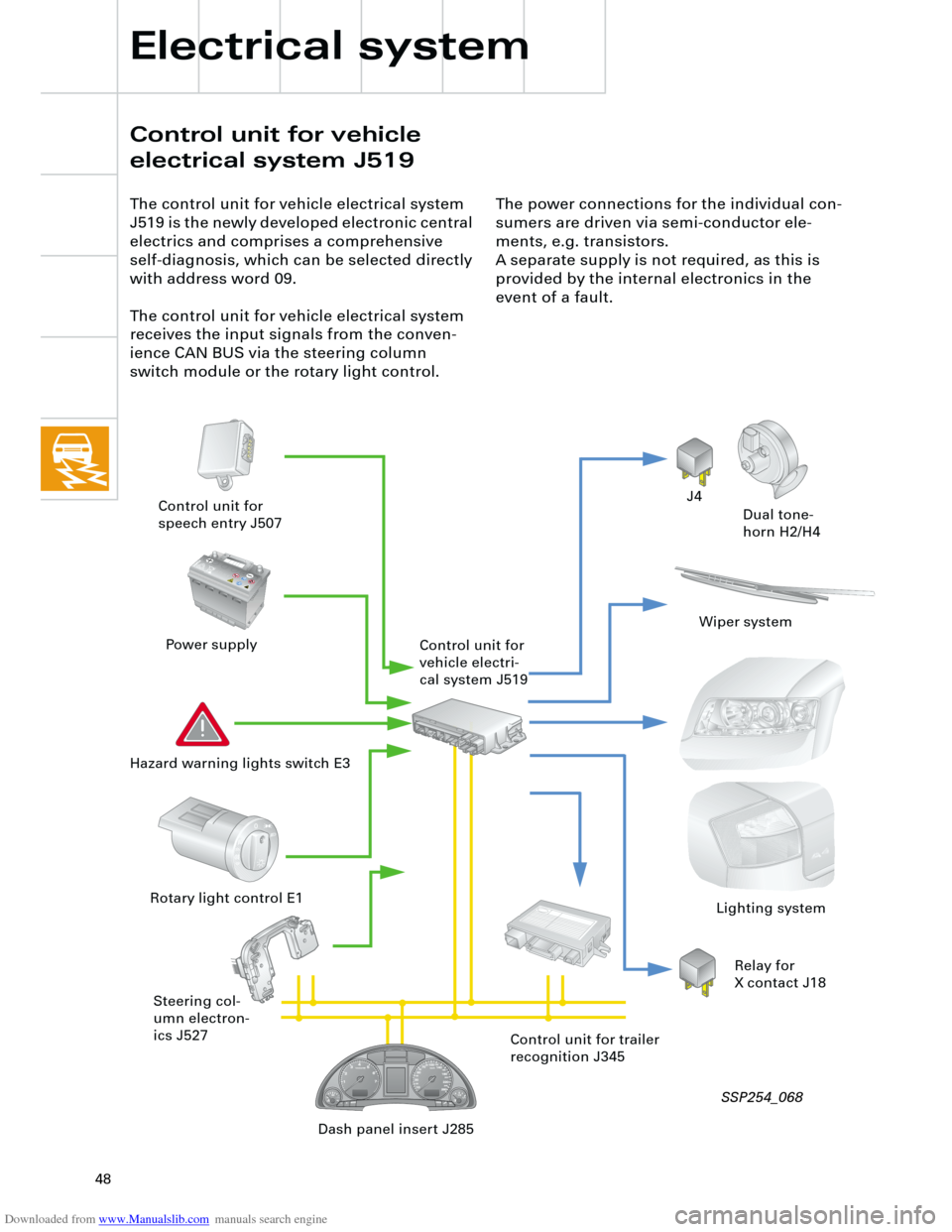
Downloaded from www.Manualslib.com manuals search engine
48
The control unit for vehicle electrical system
J519 is the newly developed electronic central
electrics and comprises a comprehensive
self-diagnosis, which can be selected directly
with address word 09.
The control unit for vehicle electrical system
receives the input signals from the conven-
ience CAN BUS via the steering column
switch module or the rotary light control.
Pb1J0 915 105 A 1J0 915 105 A
C C
The power connections for the individual con-
sumers are driven via semi-conductor ele-
ments, e.g. transistors.
A separate supply is not required, as this is
provided by the internal electronics in the
event of a fault.
J4
Dual tone-
horn H2/H4 Control unit for
speech entry J507
Power supply
Hazard warning lights switch E3
Steering col-
umn electron-
ics J527 Rotary light control E1
Wiper system
Lighting system
Dash panel insert J285Control unit for trailer
recognition J345 Control unit for
vehicle electri-
cal system J519
Relay for
X contact J18
Electrical system
Control unit for vehicle
electrical system J519
SSP254_068
Page 49 of 88

Downloaded from www.Manualslib.com manuals search engine
49
There are three control unit versions:
– "lowline" for the standard version
– "lowline" for vehicles with headlight
washer system
– "highline" for vehicles with driver informa-
tion system
The following functions are available with the
"lowline" version:
– Wash/wipe control and interval
– Hazard warning and turn signal control
– Actuation of horn and load-reduction relay
– Parking light left/right
– Side light left/right
– Main beam left/right and headlight flasher
– Number plate lightThe "highline" version implements the driver
information system function and also
performs the following control functions:
– Driving light and dipped beam left/right,
– Fog lights and rear lights,
– Reversing lights,
– Brake lights
with separate outputs to each of the individ-
ual consumers.
Light control
In the highline version, light control is trans-
mitted from the steering column switch
module or directly from the rotary light
control, via the convenience data bus, to the
vehicle electrical system control unit.
Parking lights
Main beam
Headlight flasher Side lights
Dipped beam
*
Fog lights
*
Rear fog lights
*
*
In the "lowline" version, the components marked with
an asterisk are connected via conventional wiring and
fuses, directly to the lighting units.
Control unit for
vehicle electrical
system J519
Page 50 of 88

Downloaded from www.Manualslib.com manuals search engine
50
Auxiliary signals
1 CAN high convenience
2 CAN low convenience
3 Terminal 75
4 not fitted with trailer coupling
5 only with trailer coupling
6 Automatic gearbox "multitronic"
7 Manual gearbox
A
U
X
Y
Z
Electrical system
"lowline" version
Components
E1 Light switch
E3 Hazard warning light switch
F Brake light switch
F4 Reversing light switch
F216 Contact switch for switchable
rear fog lights
H2 Treble horn
H7 Bass horn
J4 Relay for dual tone horn
J59 Load-reduction relay for x contact
J345 Control unit for trailer recognition
J446 Control unit for parking aid
J519 Control unit for vehicle electrical
system
L22 Bulb for fog light, left
L23 Bulb for fog light, right
L46 Bulb for rear fog light, left
L47 Bulb for rear fog light, right
M1 Bulb for side light, left
M2 Bulb for rear light, right
M3 Bulb for side light, right
M4 Bulb for rear light, left
M5 Bulb for turn signal light, front left
M6 Bulb for turn signal light, rear left
M7 Bulb for turn signal light, front right
M8 Bulb for turn signal light, rear right
M9 Bulb for brake light, left
M10 Bulb for brake light, right
M16 Bulb for reversing light, left
M17 Bulb for reversing light, right
M18 Bulb for side turn signal light, left
M19 Bulb for side turn signal light, right
M25 Bulb for high-level brake light
M29 Bulb for dipped beam headlight, left
M30 Bulb for main beam headlight, left
M31 Bulb for dipped beam headlight, right
M32 Bulb for main beam headlight, right
S Fuses
U10 Socket for trailer operation
V Windscreen wiper motor
V5 Windscreen washer pump
Colour coding
= Input signal
= Output signal
= Positive power supply
= Earth
= CAN-BUS
V11 Pump for headlight washer
conditioning system
V48 Servo motor for headlight range
control, left
V49 Servo motor for headlight range
control, right
X Number plate lights
Connection within the
functional diagram
Functional diagram
Control unit for vehicle
electrical system J519
{
Page 52 of 88
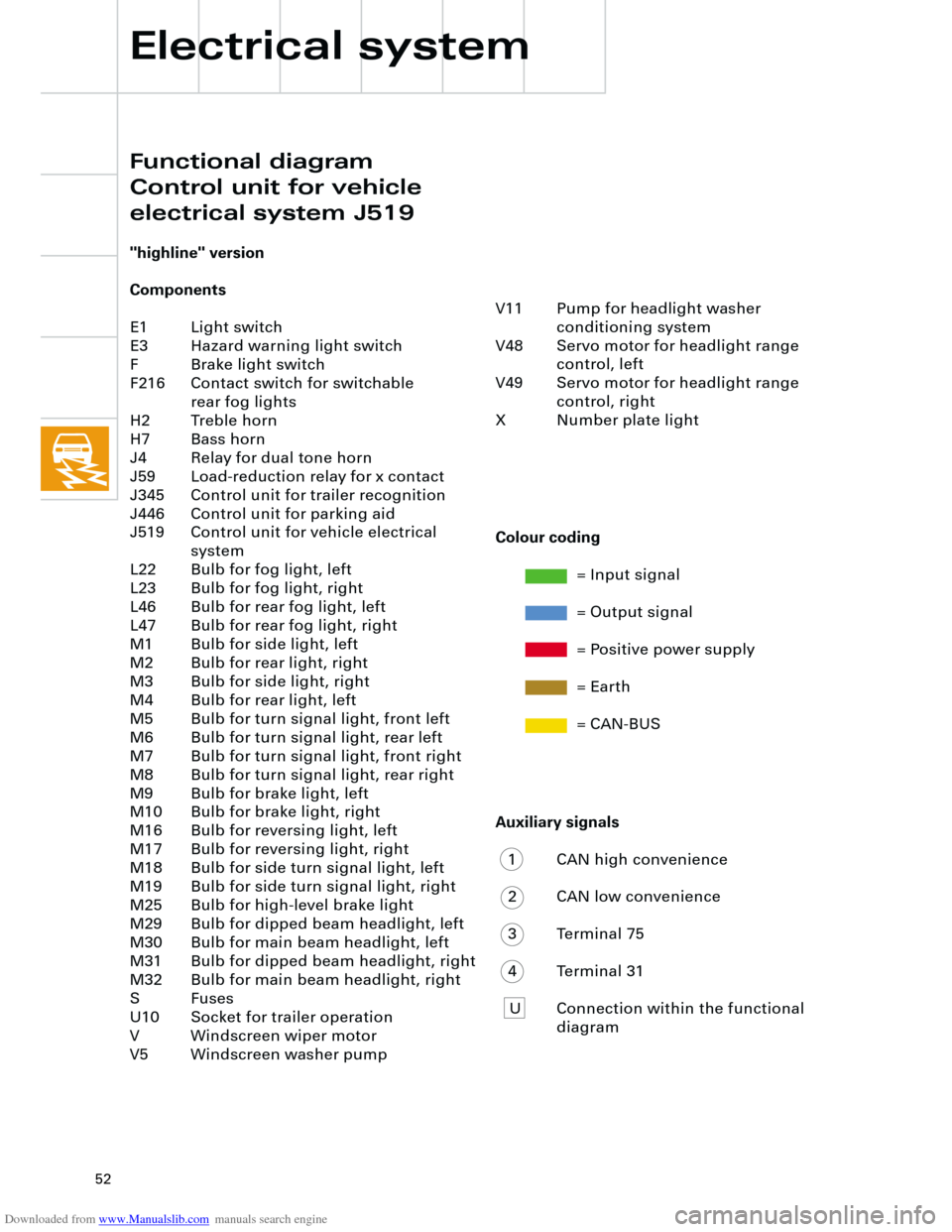
Downloaded from www.Manualslib.com manuals search engine
52
Auxiliary signals
1 CAN high convenience
2 CAN low convenience
3 Terminal 75
4 Terminal 31
U Connection within the functional
diagram V11 Pump for headlight washer
conditioning system
V48 Servo motor for headlight range
control, left
V49 Servo motor for headlight range
control, right
X Number plate light
"highline" version
Components
E1 Light switch
E3 Hazard warning light switch
F Brake light switch
F216 Contact switch for switchable
rear fog lights
H2 Treble horn
H7 Bass horn
J4 Relay for dual tone horn
J59 Load-reduction relay for x contact
J345 Control unit for trailer recognition
J446 Control unit for parking aid
J519 Control unit for vehicle electrical
system
L22 Bulb for fog light, left
L23 Bulb for fog light, right
L46 Bulb for rear fog light, left
L47 Bulb for rear fog light, right
M1 Bulb for side light, left
M2 Bulb for rear light, right
M3 Bulb for side light, right
M4 Bulb for rear light, left
M5 Bulb for turn signal light, front left
M6 Bulb for turn signal light, rear left
M7 Bulb for turn signal light, front right
M8 Bulb for turn signal light, rear right
M9 Bulb for brake light, left
M10 Bulb for brake light, right
M16 Bulb for reversing light, left
M17 Bulb for reversing light, right
M18 Bulb for side turn signal light, left
M19 Bulb for side turn signal light, right
M25 Bulb for high-level brake light
M29 Bulb for dipped beam headlight, left
M30 Bulb for main beam headlight, left
M31 Bulb for dipped beam headlight, right
M32 Bulb for main beam headlight, right
S Fuses
U10 Socket for trailer operation
V Windscreen wiper motor
V5 Windscreen washer pump
Electrical system
Colour coding
= Input signal
= Output signal
= Positive power supply
= Earth
= CAN-BUS
Functional diagram
Control unit for vehicle
electrical system J519
Page 55 of 88
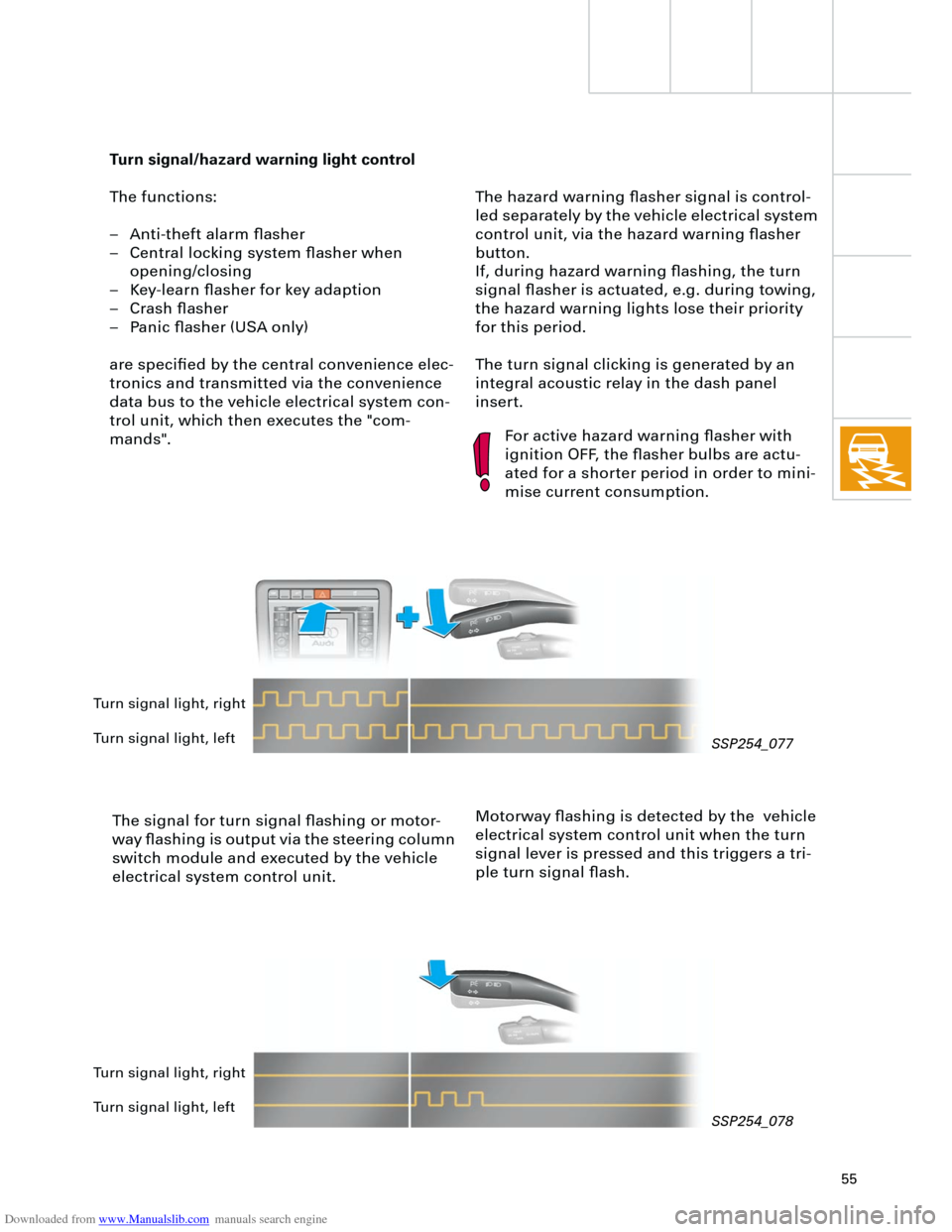
Downloaded from www.Manualslib.com manuals search engine
55
The hazard warning flasher signal is control-
led separately by the vehicle electrical system
control unit, via the hazard warning flasher
button.
If, during hazard warning flashing, the turn
signal flasher is actuated, e.g. during towing,
the hazard warning lights lose their priority
for this period.
The turn signal clicking is generated by an
integral acoustic relay in the dash panel
insert.
Turn signal/hazard warning light control
The functions:
– Anti-theft alarm flasher
– Central locking system flasher when
opening/closing
– Key-learn flasher for key adaption
– Crash flasher
– Panic flasher (USA only)
are specified by the central convenience elec-
tronics and transmitted via the convenience
data bus to the vehicle electrical system con-
trol unit, which then executes the "com-
mands".
The signal for turn signal flashing or motor-
way flashing is output via the steering column
switch module and executed by the vehicle
electrical system control unit.
For active hazard warning flasher with
ignition OFF, the flasher bulbs are actu-
ated for a shorter period in order to mini-
mise current consumption.
Motorway flashing is detected by the vehicle
electrical system control unit when the turn
signal lever is pressed and this triggers a tri-
ple turn signal flash.
Turn signal light, right
Turn signal light, left
Turn signal light, right
Turn signal light, left
SSP254_077
SSP254_078
Page 56 of 88
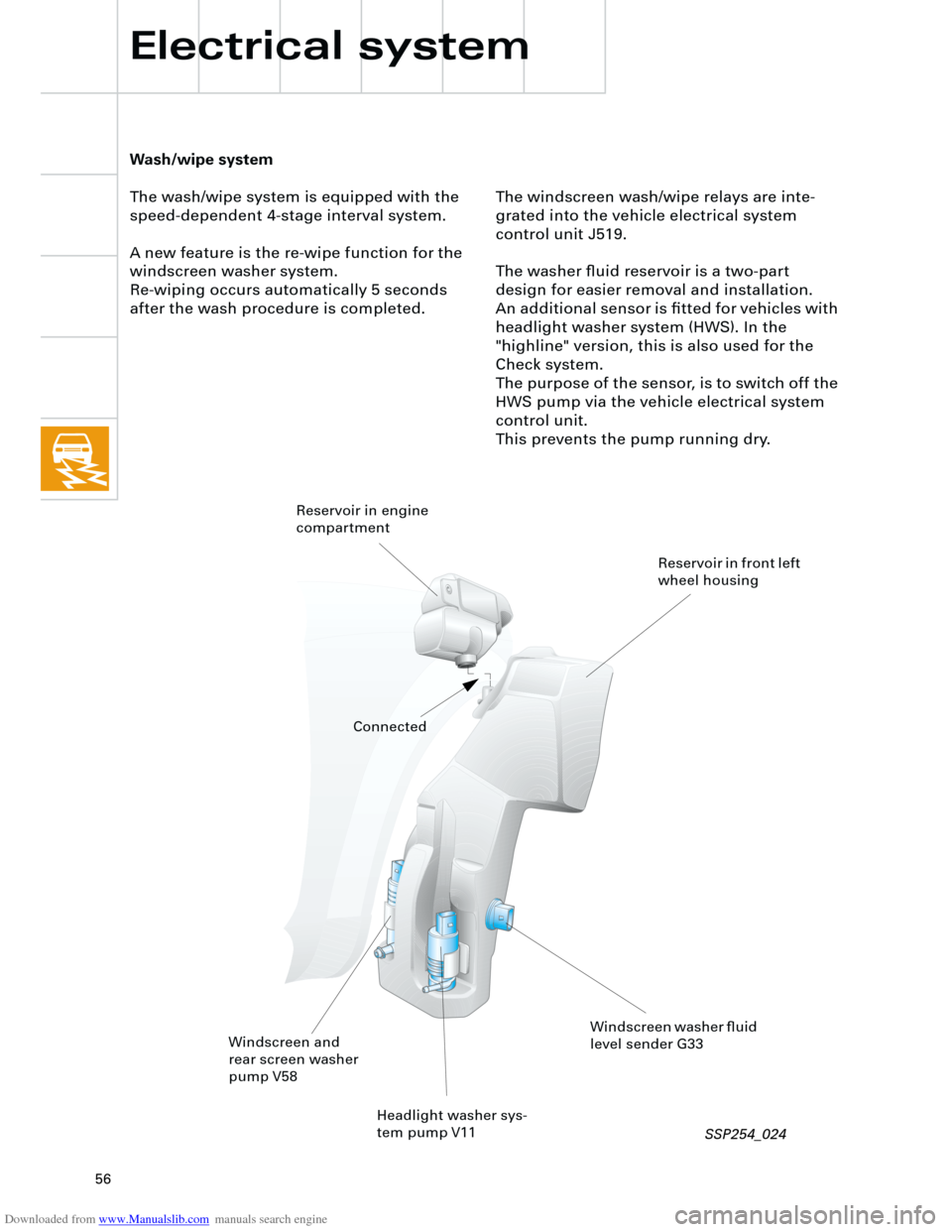
Downloaded from www.Manualslib.com manuals search engine
56
Electrical system
The windscreen wash/wipe relays are inte-
grated into the vehicle electrical system
control unit J519.
The washer fluid reservoir is a two-part
design for easier removal and installation.
An additional sensor is fitted for vehicles with
headlight washer system (HWS). In the
"highline" version, this is also used for the
Check system.
The purpose of the sensor, is to switch off the
HWS pump via the vehicle electrical system
control unit.
This prevents the pump running dry.
Wash/wipe system
The wash/wipe system is equipped with the
speed-dependent 4-stage interval system.
A new feature is the re-wipe function for the
windscreen washer system.
Re-wiping occurs automatically 5 seconds
after the wash procedure is completed.
Headlight washer sys-
tem pump V11
Windscreen and
rear screen washer
pump V58
Windscreen washer fluid
level sender G33 Reservoir in engine
compartment
Reservoir in front left
wheel housing
Connected
SSP254_024
Page 84 of 88
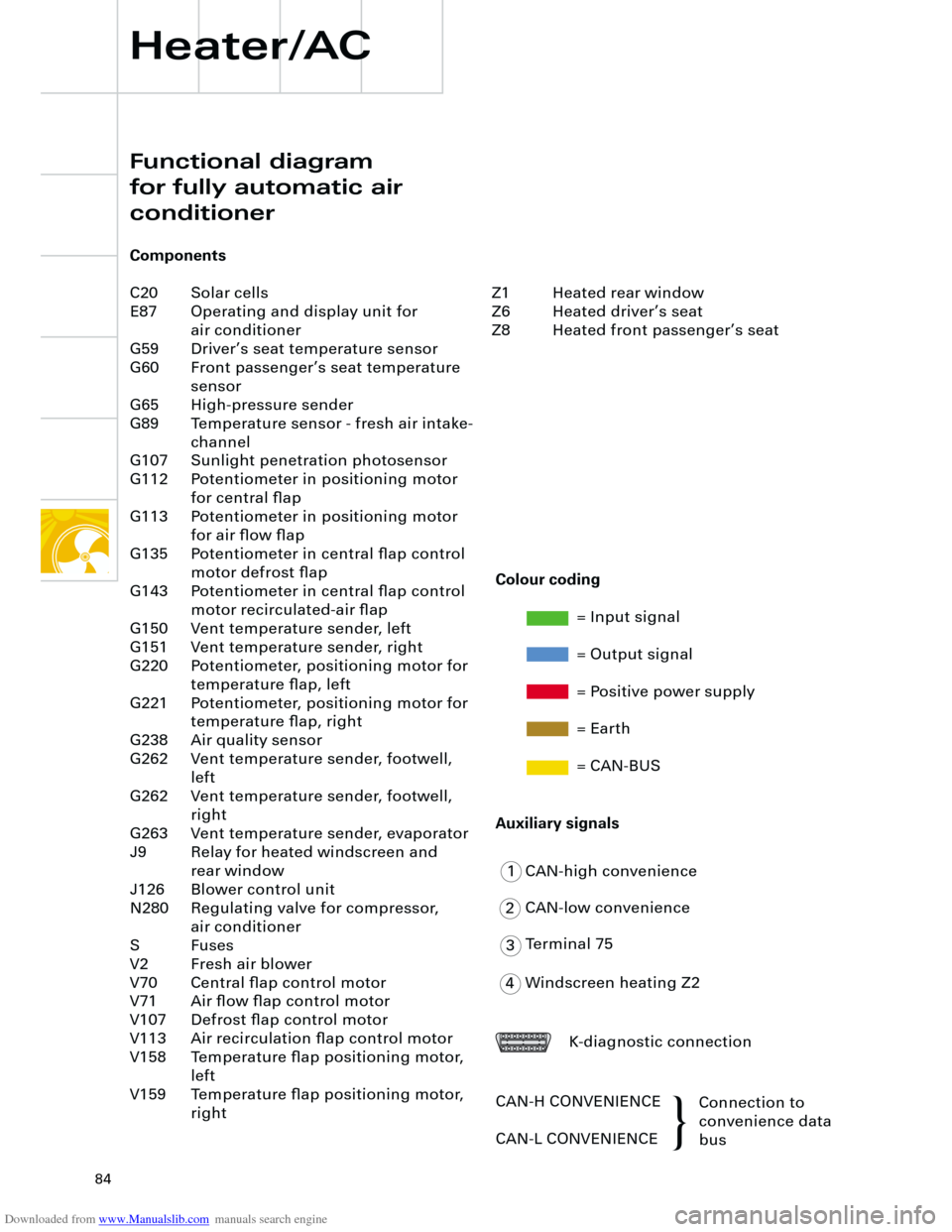
Downloaded from www.Manualslib.com manuals search engine
84
Heater/AC
Functional diagram
for fully automatic air
conditioner
Components
C20 Solar cells
E87 Operating and display unit for
air conditioner
G59 Driver’s seat temperature sensor
G60 Front passenger’s seat temperature
sensor
G65 High-pressure sender
G89 Temperature sensor - fresh air intake-
channel
G107 Sunlight penetration photosensor
G112 Potentiometer in positioning motor
for central flap
G113 Potentiometer in positioning motor
for air flow flap
G135 Potentiometer in central flap control
motor defrost flap
G143 Potentiometer in central flap control
motor recirculated-air flap
G150 Vent temperature sender, left
G151 Vent temperature sender, right
G220 Potentiometer, positioning motor for
temperature flap, left
G221 Potentiometer, positioning motor for
temperature flap, right
G238 Air quality sensor
G262 Vent temperature sender, footwell,
left
G262 Vent temperature sender, footwell,
right
G263 Vent temperature sender, evaporator
J9 Relay for heated windscreen and
rear window
J126 Blower control unit
N280 Regulating valve for compressor,
air conditioner
S Fuses
V2 Fresh air blower
V70 Central flap control motor
V71 Air flow flap control motor
V107 Defrost flap control motor
V113 Air recirculation flap control motor
V158 Temperature flap positioning motor,
left
V159 Temperature flap positioning motor,
right
1
2
3
4CAN-high convenience
CAN-low convenience
Terminal 75
Windscreen heating Z2
K-diagnostic connection
CAN-H CONVENIENCE
CAN-L CONVENIENCEConnection to
convenience data
bus
Colour coding
= Input signal
= Output signal
= Positive power supply
= Earth
= CAN-BUS
Auxiliary signals
Z1 Heated rear window
Z6 Heated driver’s seat
Z8 Heated front passenger’s seat
{